Wekiu Bugs
|
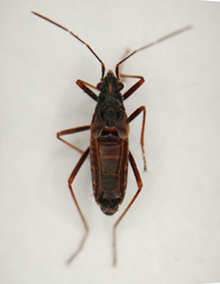
Male Wekiu Bug
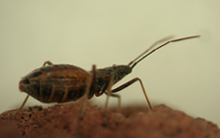
Female Wekiu Bug
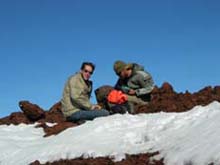
Jesse Eiben and Jaco
Le Roux
atop Mauna Kea.
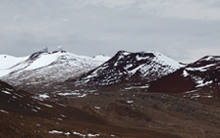
View of the summit of Mauna Kea
from the northeast
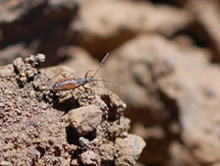
Male Wekiu Bug in the Wild
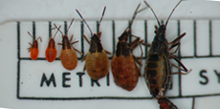
Wekiu Bug size progression
from nymph to adult

Nysius species diversity |
|
Jesse
Eiben is studying the life history and population genetics
of the wekiu bug (Nysius wekiuicola). This unique
Hawaiian flightless bug lives only on the inactive volcanic
mountain of Mauna Kea. Very little about the life of
this rare bug has been described since its formal discovery
in the early 1980s.
Life History and Population Genetics of the Wekiu Bug
The alpine habitat on Mauna Kea represents one of the most extreme environments in the Hawaiian Islands. Daily temperature fluctuations between 108ºF and 25ºF, winter snow pack, and virtually no plant life suggests lifelessness. However, there is a specialized endemic fauna.
One of the best known Hawaiian endemic insects to have evolved on the volcano summit is the wekiu bug. The wekiu bug is an insect predator-scavenger that tolerates very cold temperatures and preys exclusively on low-elevation insects deposited near the summit and immobilized by wind and cold. This micropterous seed bug is restricted to the cinder cones of Mauna Kea above 11,700 ft, and exhibits the most extreme specializations of morphological and behavioral characters in the genus Nysius.
The wekiu bug, and other Mauna Kea endemic species, may be threatened by habitat loss due to astronomy development or global warming factors stressing this fragile ecosystem. The wekiu bug is a candidate for listing under the endangered species act. Through cinder composition studies, transects, and live-trap sampling, the range of suitable habitat for the wekiu bug has recently been expanded, including two new cinder cone populations found in April 2006 (Porter and Englund, 2006).
We are for the first time maintaining wekiu bugs in captivity in temperature and environmental controlled conditions. This research addresses the unknown life history of the wekiu bug and will be used to create robust and scientifically valid life table to be used for the conservation and management decisions concerning the wekiu bug. We are investigating the genetic structure of the wekiu bug populations to determine population isolation as it relates to these conservation efforts.
|
Phylogenetics of the Hawaiian Nysius
We are investigating the molecular phylogeny of the endemic Hawaiian radiation of Nysius seed bugs, including the unique and anomalous wekiu bug, Nysius wekiuicola (Ashlock and Gagné). The Hawaiian Nysius contain a quarter of the world's species in the genus, with the wekiu bug (and its sister species the Mauna Loa bug, N. aa) showing the most extreme deviation from the standard Nysius character set. The Hawaiian Nysius seed bugs are widely distributed in drier environments on all of the Hawaiian Islands, from Midway to the Island of Hawaii.
While all other Nysius are seed-feeders typical of the family Lygaeidae, N. wekiuicola and N. aa are both flightless, micropterous, cold tolerant, scavenger-predators of moribund insects on the 13,790 ft volcanoes of Mauna Kea and Mauna Loa on the island of Hawaii. The wekiu bug is a candidate for listing under the Endangered Species Act, due to its decreasing numbers, limited range, specialized habitat requirements, isolated populations, and habitat destruction. Low levels of mtDNA variation suggest that the wekiu bug and Mauna Loa bug are very recently diverged. In addition, they are closely related to other Hawaiian Nysius indicating a rapid adaptive shift from the standard morphology and feeding of the rest of the Hawaiian seed bugs.
|
Results
Wekiu Bug Life History: We have established lab protocols to successfully keep wekiu bugs in captivity. The wekiu bug colony is being used to describe the bug’s life cycle, nymphal description and development, fecundity and natality, and to create a temperature dependent growth curve of the insect. This baseline data is being used to advise the conservation community concerned with the potential factors having led to the apparent decline in wekiu bug numbers on Mauna Kea.
Wekiu Bug Population Genetics: With a robust sampling of wekiu bugs from all cinder cone populations on Mauna Kea, we have a rough picture of the genetic variation seen between potential disparate populations of the bugs. So far, using mitochondrial DNA and nuclear DNA, there are a very limited number of DNA haplotypes of wekiu bugs on Mauna Kea.
Phylogenetics of the Hawaiian Nysius: Since many Nysius are considered agricultural pests and Hawaii’s status of the invasive species capital of the world, it is important to have up-to-date taxonomic information available for the entomological community in research and agriculture. Collections of Hawaiian Nysius from all major islands and many of the Northwest Hawaiian Islands have provided a robust sample of the extant Hawaiian Nysius. Phylogenetic analyses indicate the endemic Hawaiian Nysius seed bugs are not a monophyletic group. The NWHI Nysius are quite distinct from the Main Hawaiian Islands, and these two lineages in Hawaii indicate a very rare occurrence of separate introductions and species radiations within the same genus. We are using our recent collections of endemic and introduced Nysius to re-write the Dichotomous key and create an interactive Lucid key of Nysius found in Hawaii which has been updated only occasionally since it’s major revision in 1942 by Dr. Usinger.
Eiben, J. E. and D. Rubinoff. 2014. Application of agriculture-developed demographic analysis for the conservation of the Hawaiian alpine wekiu bug. Conservation Biology. 28:1077-88 doi: 10.1111/cobi.12315. |
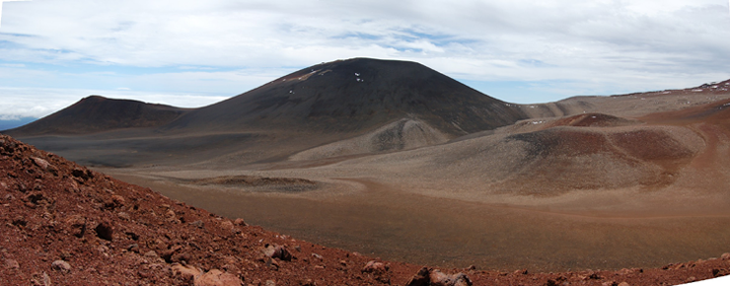
Pu'u Makanaka and glacial erosion
from 16,000 years ago
||
|







